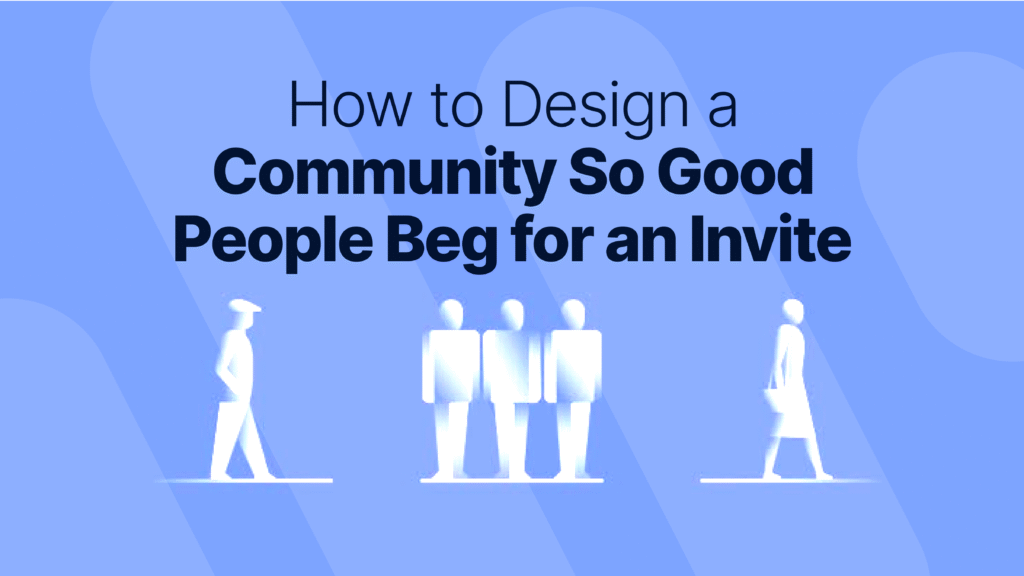Picture this: you launch a community and within weeks, you have a waitlist of thousands trying to get in. Members are sharing screenshots of their acceptance emails like they just passed the bar. Sound too good to be true? It’s not.
Some of the most successful communities today have mastered the art of making exclusivity feel like a privilege, not a barrier.
The secret isn’t just about limiting access. It’s about building something so good, so fun, and so useful that people want to be part of it.
In this article, we’re breaking down 7 simple ways to make your community feel like the place to be, where everyone wants in but only the right people get through the door.
- Create clear value that’s immediately obvious
The first rule of an irresistible community is this: people should understand exactly what they’re getting within seconds of hearing about it.
Vague promises like “connect with like-minded people” don’t cut it anymore. You need to be specific about the transformation, knowledge, or opportunities your community provides.
Take Morning Brew’s community as a perfect example. They don’t say “come and read news.” Instead, they promise to improve your life in 5 minutes.
They provide daily insider access to a media empire that reaches millions, plus exclusive job opportunities at the hottest startups before they’re posted anywhere else.
See? The value is crystal clear and immediately compelling.
- Master the art of social proof without being obvious
Nothing makes people want something more than seeing others desperately want it too. But the key is letting this desire bubble up naturally rather than shouting “Look how popular we are!”
Clubhouse nailed this during their early days. They didn’t need to advertise their exclusivity because every conversation on Twitter seemed to be someone asking for an invite. They let their members do the marketing by creating FOMO organically.
People were literally trading Clubhouse invites like concert tickets because the social proof was everywhere, but it felt authentic.
Same thing with Superhuman, the email app. They didn’t go around bragging about how elite they were. They just made every detail of their product feel high-end. People waited months to get in, and when they finally did, they were genuinely excited to share it.
The hype was real because the experience matched the build-up.
Figure out how to make other people toot your horn for you. It’s far better than doing it yourself.
- Build rituals that create belonging
The best communities don’t just give people access to information, they give them access to experiences they can’t get anywhere else. These shared rituals become the stories members tell their friends, making others desperate to be part of the inside circle.
Patagonia’s community perfected this with their community culture. They don’t just sell outdoor gear—they create shared missions around environmental activism.
Members participate in beach cleanups, advocate for public lands, and share stories of adventure that all tie back to the brand’s values. The rituals make members feel like they’re part of a movement, not just a customer base.
- Curate conversations like a museum curator
In most communities, people just say whatever they want, and it shows. But the best ones? They’re super thoughtful about what kind of conversations they allow. It’s not about being snobby or shutting people out. It’s about making sure every post, reply, or chat actually adds something. When a community keeps that bar high, people notice.
Reddit’s r/AskHistorians demonstrates this perfectly. They have incredibly strict moderation standards where every answer must be comprehensive, accurate, and sourced.
Comments that don’t meet their standards get removed, no matter how popular they are. As a result, it’s become the gold standard for historical discussion online, and historians compete to contribute because the quality bar is so high.
This way, members know that every conversation will be worth their time.
- Create multiple tiers of exclusivity
The smartest communities create multiple levels of access that give people something to aspire to within the community itself.
This keeps engagement high and makes the most valuable tier feel even more special.
American Express does this masterfully with their card tiers, but their Centurion Lounge community takes it further.
Regular Platinum members get basic access, but Centurion members get exclusive events, private dining experiences, and first access to new locations. Each tier has clear benefits, and members naturally want to climb the ladder.
GitHub sponsors created a similar dynamic in the developer community. Open source contributors can access basic resources, but sponsors get exclusive office hours with maintainers, early access to new features, and recognition that elevates their professional profile. The tiers make every level of participation feel rewarding while creating aspiration for the next level.
- Launch with your dream members first
Most communities make the mistake of trying to appeal to everyone from day one. The magnetic communities start by attracting a small group of their absolute ideal members first, then let that quality attract similar people naturally.
Behance did something similar by initially focusing solely on the world’s top creative professionals. They made sure their first members were people whose work everyone else admired.
When other creatives saw these legends using the platform, joining became a no-brainer. The quality of the initial community became the magnet for everyone else.
- Make exclusivity feel like curation, not rejection
The difference between a community that feels elitist and one that feels premium often comes down to how you frame access.
The best communities make people feel like they’re being selected for something special rather than excluded from something they deserve.
Soho House frames their membership process as finding the right cultural fit rather than screening out undesirable people. They talk about creating spaces where creative professionals can connect authentically, making the selection process feel like matchmaking rather than judgment.
This framing makes rejection feel less personal and acceptance feel more meaningful.
Download this checklist to help you improve your community management skills today.
Conclusion
The strategies above work because they focus on creating real worth for members first, then letting demand follow naturally.
That’s exactly what we had in mind when building Coloniz. Whether you’re starting a wide-open space that spreads through word of mouth, or something more private and curated, Coloniz gives you the tools to do it your way. You’ve got built-in crypto wallets to reward your members, funding pools for community-led projects, and privacy settings that make it easy to create tight-knit inner circles.
If you’re ready to build the kind of community people can’t stop talking about, we’ve got your back.
Start at www.coloniz.xyz.

